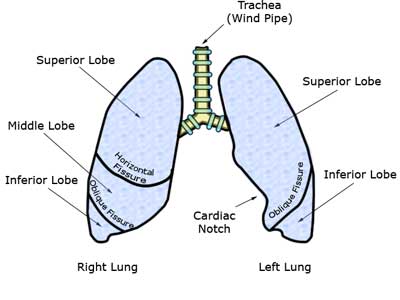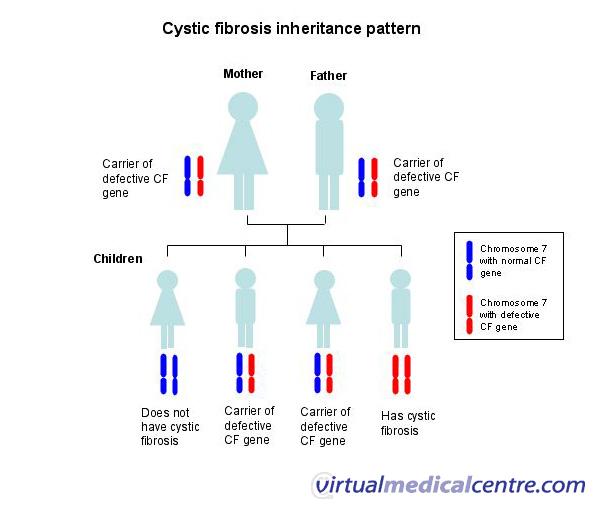- What is Cystic Fibrosis
- Statistics on Cystic Fibrosis
- Risk Factors for Cystic Fibrosis
- Progression of Cystic Fibrosis
- Symptoms of Cystic Fibrosis
- Clinical Examination of Cystic Fibrosis
- How is Cystic Fibrosis Diagnosed?
- Prognosis of Cystic Fibrosis
- How is Cystic Fibrosis Treated?
- Cystic Fibrosis References
What is Cystic Fibrosis
| Cystic Fibrosis is a recessive genetic disorder that affects the mucus lining of the lungs, which leads to breathing problems and other health problems. The lungs are composed of air passages, starting from the trachea (or windpipe) which divides into a left and right main bronchus, which keep dividing until they become bronchioles, and finally terminating into alveoli. The alveoli are small folded membranes shaped like a cluster of grapes. They are the interface between the air and blood stream and that is where gas exchange takes place. |

Cystic fibrosis is a genetic disorder of exocrine gland secretion – it leads to thickened secretions within the airways within the lungs – which can subsequently become infected. Thus the affected individual suffers from chronic infection within the lung leading to bronchiectasis. The lungs are not the only glands affected, however – numerous other organs which have exocrine glands (e.g. gut, pancreas, skin, vas deferens) are affected.
Statistics on Cystic Fibrosis
This condition is the most conmon genetic lethal disorders in Caucasian people. One in every 25 babies born in Australia will carry the cystic fibrosis gene. The number of Caucasian infants affected with cystic fibrosis ranges from 1:1600 to 1:2500. Each year 70 babies are born in Australia with cystic fibrosis. As a result, new studies into better screening programs are currently being developed.
Risk Factors for Cystic Fibrosis
Cystic fibrosis is an autosomal recessive condition – that means that a person needs two defective genes (one from each parent) to develop the condition. The gene that has been thought to cause cystic fibrosis is called cystic fibrosis transmembrane conductance regulator or CFTR. This gene has been located on chromosome 7.
Information on re-publishing of our images
Progression of Cystic Fibrosis
The severity and extent of the disease varys greatly amongst cystic fibrosis patients. In general, the condition results in defective chloride ion transport across the epithelial cells and increased viscosity of bodily secretions, specifically secretions from the respiratory tract (i.e. lungs, throat) and pancreas. As a result, the patient is predisposed to pancreatic insufficiency and recurrent chest infections.
This condition may also lead to bowel problems such as malaborption, bowel obstructions and constipation. Due to the abnormal transport of chloride ions, this abnormality can be detected in sweat. This abnormality lead to a diagnostic test for cystic fibrosis, named the sweat test.
Symptoms of Cystic Fibrosis
Children presenting with cystic fibrosis may experience recurrent chest infections and failure to thrive (i.e. not growing to normal weight and height compared to children of the same age). The child may also suffer from very smelly, light coloured stools. 10% of children that had a history of meconium ileus will have cystic fibrosis.
Clinical Examination of Cystic Fibrosis
When presenting to the doctor, the child may have signs of:
- Hyperinflation
- Crepitations
- Wheeze
- Finger clubbing
The child may appear below normal height and weight for a child of his/her age.
How is Cystic Fibrosis Diagnosed?
There are several tests that are performed to determine whether a patient has cystic fibrosis.They are as follows:
- The sweat test. This is the gold-standard diagnostic test. It is based on the pathological feature of cystic fibrosis, which is abnormal chloride ion transport. If the patient has two successive tests showing chloride levels above 60mmol/L (normal is under 15mmol/L), its conclusive that the patient has cystic fibrosis.
- CF genotyping may be used to confirm diagnosis
- A blood test is performed on infants. A heel prick blood test is performed to check for the enzyme IRT (immune reactive trypsin) is measured. If the levels are high, its suggestive of cystic fibrosis and the infants undergoes a sweat test.
Prognosis of Cystic Fibrosis
Due to recent developments into the management of cystic fibrosis, the prognosis has greatly improved. Over 90% of children diagnosed with cystic fibrosis will live to their teens. The estimated median survival age of children born in after 1990 will be 40 years. This may be further improved upon in the future by gene therapy techniques.
How is Cystic Fibrosis Treated?
Cystic fibrosis is a disease that affects many systems. Therefore, its essential that a multidisciplinary approach is taken in the management of this disease. The main goals in the management of cystic fibrosis are:
- Promote sufficient growth and nutrition
- Prevent the progression of further lung disease
This is achieved with a team of health professionals including paediatricians, physiotherapists, dieticians, counsellors and general practitioners. Specific treatments for cystic fibrosis are:
- Antibiotics to reduce risk of chest infections
- Pain relievers such as Ibuprofen may reduce lung deterioration
- Mucus-thinning drugs to reduce viscosity of mucus, making it easier to breathe
- Bronchodilators to increase air entry
- Physio exercises to remove mucus in the chest
- Improved nutrition ( high calorie diet, vitamin and mineral rich) to maintain weight and ensure essential nutrients are consumed
- Refer for counselling and support groups as chronic diseases can cause a great amount of stress for the patient and family
- Oral enzymes should be taken to aid in digestion and absorption of food
- In severe cases, a lung transplant may be suggested due to severity of disease and poor quality of life
Cystic Fibrosis References
- Cotran RS, Kumar V, Collins T. Robbins Pathological Basis of Disease Sixth Ed. WB Saunders Company, 1999. pp735-36.
- Kumar P, Clark M. Clinical Medicine. 5th Ed. WB Saunders, 2002. pp871-873.
- Pang D, Newson T, Budd C, Gardiner M. Paediatrics. Mosby, 2005. pp105-107.
All content and media on the HealthEngine Blog is created and published online for informational purposes only. It is not intended to be a substitute for professional medical advice and should not be relied on as health or personal advice. Always seek the guidance of your doctor or other qualified health professional with any questions you may have regarding your health or a medical condition. Never disregard the advice of a medical professional, or delay in seeking it because of something you have read on this Website. If you think you may have a medical emergency, call your doctor, go to the nearest hospital emergency department, or call the emergency services immediately.








